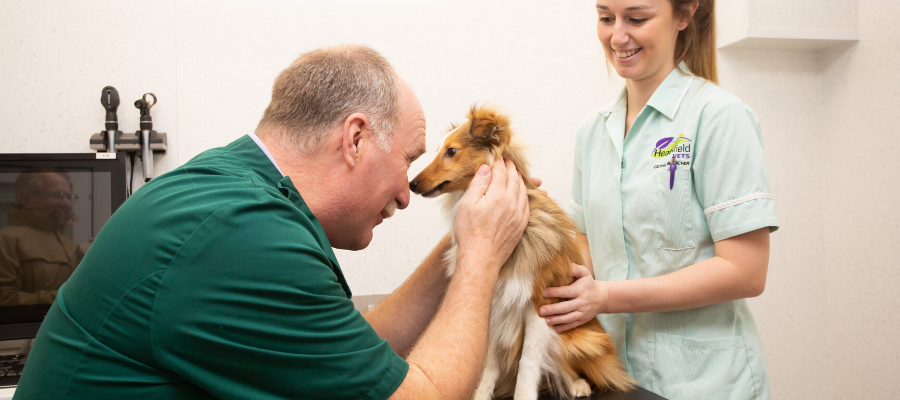
Your pet can suffer with a number of different eye health issues in their life time. It is important to recognise the signs quickly, as early intervention not only prevents pain and discomfort, but also helps save their vision in some cases. Some eye conditions are more common in certain breeds, but others are common across all pets.
Conjunctivitis
Conjunctivitis is an itchy, uncomfortable inflammation of the ‘conjunctiva’, which is the membrane which covers the eyeballs and lines the eyelids. It can be just as common in pets as it is in humans, so it’s always best to get it checked if you suspect your pet may be affected.
Signs of conjunctivitis
- Discharge from the eyes (can be watery or thick)
- Red, bloodshot eyes
- Pawing at the affected eye due to discomfort
- Blinking more than normal
- Squinting
- Eyelids sticking together
Conjunctivitis has a number of possible causes, the most common being an allergic reaction to dust, pollen, smoke or other airborne irritants. Smaller animals may be affected by dusty bedding like sawdust. It can also be caused by bacterial or viral infections, such as feline herpes. There are a few more serious causes, such as ‘dry eye’ or abnormalities to the structure of the eye.
The best thing you can do for your pet is get them to the vet as soon as you suspect an eye problem so they can be diagnosed and treated before the condition worsens. Your vet can also diagnose any underlying health issues which may have caused the infection, for example rabbits may have problems with their teeth which press against the tear ducts causing eye problems. In most cases conjunctivitis can be treated with the medicated eye drops or ointments prescribed by your vet.
Cherry Eye
‘Cherry eye’ is usually a complaint among young dogs. It is a disorder of the third eyelid (nictating membrane) which supplies nutrients to the eye via tear production. Cherry eye occurs when a gland in this membrane prolapses and appears as a pink, fleshy mass covering the eye in one corner. This can develop suddenly, even overnight in some cases.
Cherry eye predominantly affects young dogs under two with a genetic pre-disposition. English Bulldogs, Lhasa Apsos, Cavalier King Charles Spaniels, Shih Tzus, French Bulldogs, Bloodhounds, Great Danes and Boston Terriers are among those most commonly affected. The condition can also affect young cats in rare circumstances.
It is vital if you notice symptoms of cherry eye to seek treatment as soon as possible. The exposed tissue can dry out, making it susceptible to damage, infection and inflammation. If left untreated it can lead to long term eye problems and in the majority of cases surgery is required to place the gland back in its normal location. Unfortunately, the condition can recur and treatment may need to be repeated.
Eye Ulcers
A corneal ulcer occurs when the transparent layer at the front of the eye called the cornea is damaged.
Signs of corneal ulcers:
- Rubbing or pawing at the eye
- Watery eyes or an eye discharge
- Sensitivity to light
- Red, painful eye
- A film over the eye
Ulcers are most often caused by trauma to the eye due to accidental damage when playing. A foreign substance getting under the eye lid could also lead to an ulcer forming. Less common causes of ulcers include pre-existing eye conditions such as dry eye or entropion (where the eyelid rolls inward onto the surface of the eye).
Short nosed and flat faced breeds like pugs, boxers and bulldogs are more susceptible to ulcers developing, although any breed can get them. If they are not treated promptly, ulcers may progress and be described as ‘deep’ or ‘melting’. These ulcers are potentially very serious and may require drops several times a day and possibly surgery to address them.
An ulcer is diagnosed through a thorough eye examination and a ‘fluorescein test’, whereby a special dye is applied to the eye so the vet can visualise damage to the cornea and diagnose an ulcer. Treatment usually involves antibiotic and repairing eye drops, alongside regular check ups to check the ulcer is healing appropriately. We recommend seeking the advice of a vet as soon as any issue with the eye is noticed.
Dry Eye
Dry eye or keratoconjuctivitis sicca (KCS) occurs when tear production in impaired, resulting in inflammation of the cornea due to drying. The condition is very painful and will get worse if left untreated.
Dry eye can be caused by an immune related disorder which causes the body’s immune system to attack the glands which produce tears. It can also be secondary to viral infections like distemper in dogs and feline herpes in cats or hormonal diseases like hypothyroidism. Dry eye can also occur as a side effect to certain medications.
Signs of dry eye:
- Red, irritated eyes
- Squinting or excessive blinking
- Dull look to eyes, lacking shine
- Recurrent eye infections or ulcers
- Thick discharge around the eyes
Dry eye is diagnosed using the Schirmer Tear Test – a simple test which has been around for over 100 years and is used on humans and animals alike. A small strip of special wicking paper is held onto the lower lid for about a minute. Tears will travel up the specially marked paper strip, giving an indication of tear production levels. Vets will also look extensively at the clinical history for a patient as well as performing a full health check to diagnose any underlying issues.
Dry eye can be treated with medicated eye drops, with the aim to replace the tear film and stimulate tear production. Patients may also need antibiotics or anti-inflammatory medications to treat inflammation or infection.
Whilst dry eye is a serious condition, if diagnosed and treated early before any corneal scarring can occur, the prognosis is good. Lifelong medication will be required as well as regular check-ups with the vet to maintain your pet’s eye health.
Eyelid Growths
It is not uncommon to find lumps around your dog’s eyes, either due to a blocked gland or a tumour. Small tumours can develop due to an overproduction of cells of the skin or glands of the eyelids. Thankfully, most eyelid growths are benign but can become ulcerated or infected, leading to severe irritation and pain for your pet due to their location. If you notice any lumps around your dog’s eyes or eye irritation it is best to get them checked by a vet.
In order to diagnose the type of tumour being dealt with the vet may perform a fine needle aspirate, whereby a small number of cells are removed by needle from the lump and sent away to an external laboratory to be analysed. Depending on their size and location growths can be removed surgically either with sedation or general anaesthetic.
Call us on 01435 864422 if you have any concerns about your pet’s eye health.

